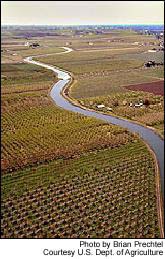forum
library
tutorial
contact

Washington Farmers Lease Water Rights to Help Fish
by StaffEnvironmental News Network, July 17, 2001
|
the film forum library tutorial contact |

|
Washington Farmers Lease Water Rights to Help Fishby StaffEnvironmental News Network, July 17, 2001 |
 Mike and Kelly Moeur of Ellensburg, Washington and Robert and Shirley Stewart, who own property in Ellensburg, are leasing their water rights to the Washington State Department of Ecology to keep the water in streams for fish.
Mike and Kelly Moeur of Ellensburg, Washington and Robert and Shirley Stewart, who own property in Ellensburg, are leasing their water rights to the Washington State Department of Ecology to keep the water in streams for fish.
Much of the state experienced the driest winter in 71 years, prompting Govenor Gary Locke to declare a drought emergency on March 14 that is still in effect.
Water flows are less than half of the average for this time of year in three of the state's major rivers including the Yakima River which runs through Ellensburg in central Washington. This year, the Yakima River will have only 44 percent of its average flow, officials predict. The rest of the state's largest rivers will have between 50 and 70 percent of their average flows.
For the past 30 years, the Moeurs grew timothy hay on their farm. This year, they have chosen not to withdraw water. Instead, they signed a temporary lease to keep approximately 408 acre-feet, or 13.2 million gallons, of water in Spring Creek and the Yakima River. The state Department of Ecology is leasing the water from the Moeurs for $52,500.
For the past 25 years, the Stewarts also grew hay and pasture and raised cattle. Ecology will pay the Stewarts $30,000 to keep approximately 232 acre-feet, or 7.6 million gallons, of water in the Yakima River this year.
Their water leases to the state were made possible by the first water law revisions in 30 years. The state has made water rights processing more flexible so water is available where it is needed most.
Two lines for water-right applications have been created -- one for new rights and one for changing or transferring existing water rights. This allows faster action on change or transfer requests that have been long stuck in line behind requests for new water rights.
Family farms in rural areas are allowed to temporarily transfer their rights to other uses, helping others during the drought.
A tax incentive to conserve and re-use water was created. In addition, the taxes paid by utilities that conserve or reuse water go into the special fund to lease and buy water rights for endangered fish.
"We should celebrate our collective success in securing long-needed water policy changes for people, farms and fish," Locke said. "It also should mark our collaborative, bipartisan commitment to move forward."
As a result, the Department of Ecology has $3.5 million in state funds and authority to spend up to $6 million in federal funds to purchase or lease water rights. People or businesses interested in donating, selling or leasing their water rights should contact Ecology's drought hotline at 800-468-0261.
"We are so pleased that the Moeurs and Stewarts joined our efforts to help fish survive this year," said Ecology Director Tom Fitzsimmons. "Thanks to them and other people who are coming forward to offer their assistance, our fish populations have a better chance of making it through this incredibly difficult drought year."
Both fish and farmers are having a tough time this year. Farmers, who rely on about 75 percent of the water used in the state, are facing crop losses due to lack of water. Several runs of salmon and steelhead, already having a hard time surviving, are at even greater risk with low stream flows.
Governor Locke has made requests of U.S. Agriculture Secretary Ann Veneman to designate 13 Washington counties agricultural disaster areas due to devastating crop damage from June storms, and to declare six counties agriculture disasters as a result of drought. These designations would provide emergency low-interest Farm Service Agency loans to farmers and ranchers.
The July forecast by the National Weather Service indicates that the amount of water in several major Washington rivers will be significantly less than predicted in June.
The agency predicted that, from April through September, the amount of water in those rivers would be at least 40,000 acre-feet, or 13 billion gallons, less than the amount forecasted in June.
For the Columbia River, the region's largest, the estimated amount of water is down by one million acre-feet between the June and July forecasts.
"If the forecasts prove accurate, this is significantly less water than we were hoping would be in the rivers," said Doug McChesney, who coordinates the drought response for the Department of Ecology. "This forecast indicates that we may have serious low flow problems during the driest months, when water is needed both to irrigate crops and help fish migrate."
State officials are asking Washington residents to water their lawns every other day or let them go brown. Make sure water goes onto the intended plants and grasses, not sidewalks or driveways, officials advise.
learn more on topics covered in the film
see the video
read the script
learn the songs
discussion forum
